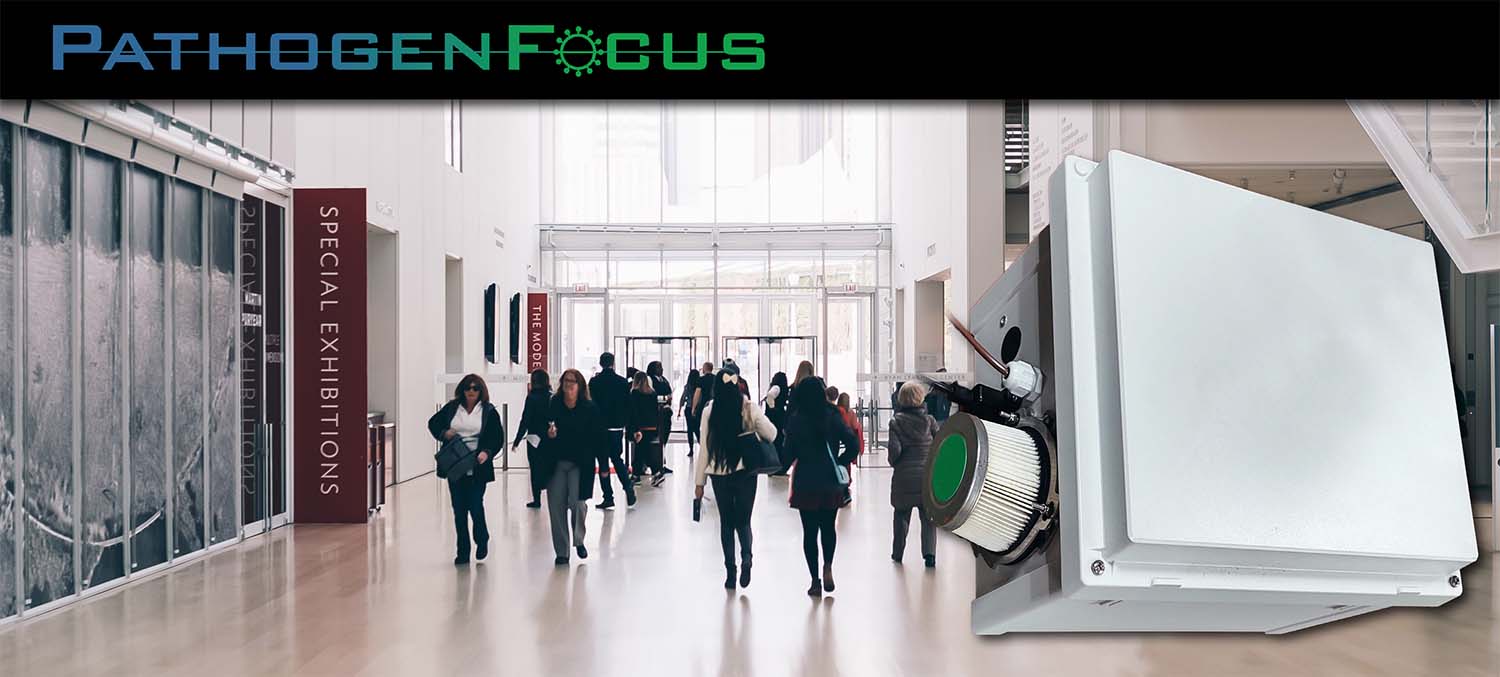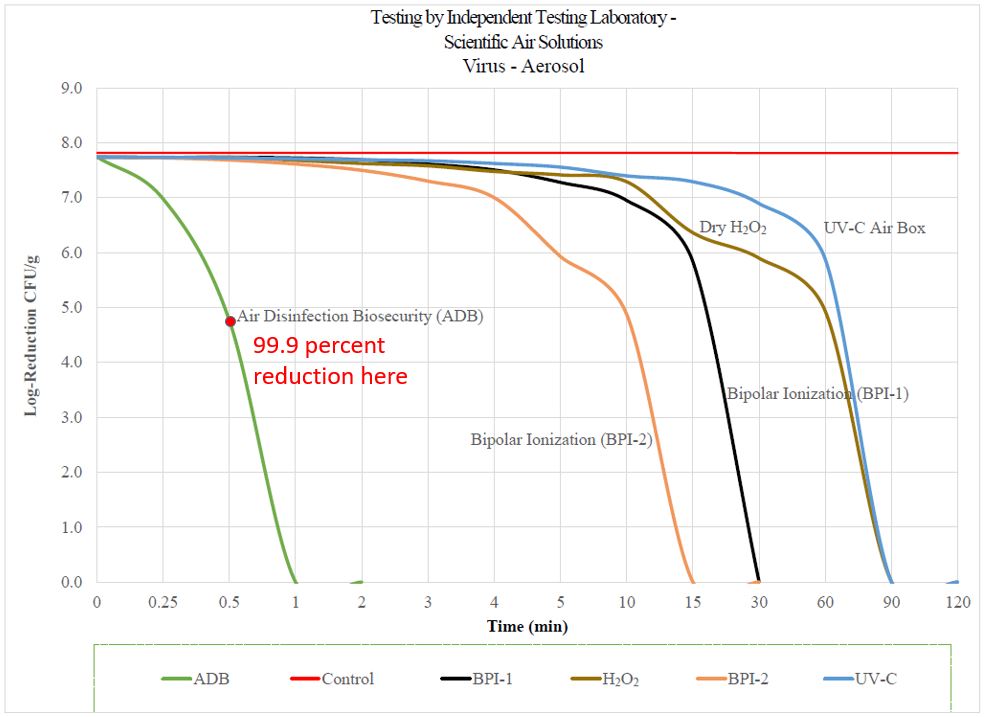
LumenFocus recently launched a new line of anti-viral and anti-bacterial products called PathogenFocus.
PathogenFocus products utilize state-of-the-art Air Disinfection Biosecurity technology. These units work in conjunction with existing HVAC systems and are available in many different sizes for a wide range of building spaces. Portable units are also available.
ADB technology provides 24/7 continuous air and surface disinfection, and is scientifically validated to eliminate up to 99.99 percent of common pathogens (including SARS-CoV-2, the novel coronavirus that leads to COVID-19).
Click here to view the new PathogenFocus.com website

In independent third-party testing, ADB reduced airborne viruses by 90 percent in 16 seconds, and by 99.9 percent in 30 seconds. At the one-minute mark, aerosolized viruses are virtually eliminated, with an 8-log (99.999999 percent) reduction.
On surfaces (steel, plastic, fabric and linoleum), ADB reduces viruses by 99.9 percent in 11-12 minutes.
ADB had similar success against bacteria. Airborne bacteria are 99.9 percent eradicated by ADB in under 60 seconds. On surfaces, bacteria are eliminated in 11-13 minutes.
Scientific studies available upon request.
ADB is also effective in neutralizing molds and mildew. Candida auris is a particularly deadly fungus and is responsible for many Healthcare Acquired Infections (HAIs). According to The Centers for Disease Control and Prevention, one in three patients with an invasive Candida auris infection die. It is resistant to many medicinal treatments, according to the Centers for Disease Control and Prevention. ADB can reduce Candida auris by 99.99 percent on surfaces in 30 minutes. It can reduce aerosolized Candida auris by 99.996 percent in 4-5 minutes.
Where can ADB be used?
ADB is a quick, effective and safe anti-pathogen solution. Therefore, it can be useful for many applications, such as: K-12 and higher education, buses, offices, meeting rooms, break rooms, healthcare, food/meat processing, restaurants, freight, locker rooms, subways, industrial/commercial spaces, senior care/assisted living, horticulture, grocery, retail, and more.
Read more about ADB applications here
What advantages does ADB provide?
Two of the biggest advantages of Air Disinfection Biosecurity technology are speed and safety.
Speed is critical when it comes to combating pathogens, especially those as contagious as SARS-CoV-2. ADB was tested in a third-party independent testing laboratory against three other methods – bipolar ionization, dry H202, and a UVC air box. ADB achieved a 99.9 percent reduction of aerosolized viruses in about 30 seconds. The next fastest method was bipolar ionization, which took nearly 10 minutes to achieve the same level. On surfaces (stainless steel, plastic, linoleum and fabric), ADB reached a 99.9 percent reduction of viruses in just over 10 minutes. Bipolar ionization reached that same level in just under an hour.

ADB technology had similar success against bacteria – reducing aerosolized bacteria by 99.9 percent in just under a minute. Bipolar ionization, again the next fastest implement, took nearly 10 minutes to achieve a 99.9 percent reduction. For bacteria on surfaces, ADB achieved the 99.9 percent reduction mark at 10-12 minutes, while bipolar ionization achieved that mark in about one hour.
Why is speed so important? The typical person exhales about 0.25 cubic feet of air in one minute.* In the 16 seconds required for ADB to inactivate 90 percent of an airborne virus, that translates to just 0.07 cubic feet of air. This leaves only 0.007 cubic feet of infected air that can possibly create transmission of the virus. Fourteen seconds later, even that is virtually all eliminated, with the elimination percentage being 99.9 percent in 30 seconds. Due to the speed in which ADB can inactivate viruses like SARS-CoV-2, this severely limits the chances of transmission from person to person.
The other major advantage for PathogenFocus ADB units is safety. UVC is effective against pathogens but is hazardous to the skin and eyes of humans. When UVC is utilized, it must be either in unoccupied spaces, or in indirect applications such as enclosed air boxes or upper air irradiation units. UVC also relies more heavily on line-of-sight, so it is not a perfect solution for hard-to-reach areas. ADB is not restricted to line-of-sight.

Because these systems are safe for humans, they can continue to operate in occupied spaces when the protection is needed the most.
ADB provides many advantages to other anti-pathogen methods:
- Rapid and continual antimicrobial technology, even in hard-to-reach areas
- Long-term cost savings in chemical use and staff labor – ADB uses no consumables
- Smart controller included in many models for ease of use
- No downtime as ADB is safe to use in occupied spaces
- Chemical-free and residue-free
- No air filtration, ionizers, irradiation or harmful UV components
How does it work?
ADB technology is a safe, scientifically validated antiviral and antimicrobial technology that achieves continuous inactivation and neutralization of viruses, bacteria, molds, mildews, and volatile organic compounds (VOCs) through an advanced air and surface disinfection process.
- Ambient air is captured and exposed to high frequency controlled electrical pulses within the system’s chamber.
- This creates a burst of charged particles, referred to as Reactive Oxygen Species (ROS) and include hydrogen peroxide
- These reactive particles are then dispersed through the air via the existing HVAC, or from the portable unit.
- The charged particles contact air and surface pathogens, destroying their DNA/RNA, rendering them inactive, and reducing the microbial burden.
This process is similar to how the human body fights off pathogens. Within our own body’s immune system, when a microbe is recognized by phagocytes and engulfed, a natural immune response called respiratory burst is initiated. Much of this process within our own body’s immune response centers around this very reaction of superoxide and water to create hydrogen peroxide (H202), as well as the reaction of singlet oxygen, which will oxidize many of a microbe’s cellular components. In a way, ADB is essentially taking this part of our body’s natural immune response to pathogens and bringing it out into our building spaces. Once the reaction is complete, what is left is water vapor and non-reactive O2. Learn more about the science behind ADB here: www.pathogenfocus.com/the-science.
Read more about PathogenFocus on the new website here: www.pathogenfocus.com, where you can learn more about the science behind how it works, read success stories, testimonials, and frequently asked questions.
Click here to download this as a press release (.pdf).
*Source: https://www.sciencedirect.com/topics/medicine-and-dentistry/respiratory-minute-volume. Humans breathe about 6 liters per minute, which translates to less than 0.25 cubic feet.